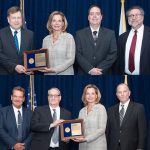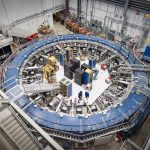From Gizmodo, Jan. 25, 2020: Physicists have found all of the particles and forces that the Standard Model describes, but there are still countless mysteries in the universe that the theory fails to explain. Various experiments are now probing the Standard Model for cracks, and this year, scientists hope to unveil a measurement from one of them, the Muon g-2 experiment, a measurement that might break from the theory.
Muon g-2
From Nature, Dec. 20, 2019: Fermilab should unveil long-awaited results from Muon g–2, a high-precision measurement of how muons — more-massive siblings of electrons — behave in a magnetic field. Physicists hope that slight anomalies could reveal previously unknown elementary particles.
From Gizmodo, Oct. 23, 2019: Ahead lies a whole frontier in particle physics of grand unsolved mysteries, including why there’s more matter than antimatter in the universe, what the true identity of dark matter and dark energy is, or how the strange, ultraweak neutrino particles ended up so ghostly. The Fermilab-hosted DUNE and Muon g-2 experiments are among those looking for answers.
From Johannes Gutenberg University Mainz, Sept. 30, 2019: Johannes Gutenberg University Mainz strengthens its relationship with Fermilab by joining the Muon g-2 collaboration. Muon g-2 aims at a determination of the muon anomalous magnetic moment with the unprecedented precision of 140 part per billion. This fourfold improvement over the last experiment, performed at Brookhaven National Laboratory more than 15 years ago, will allow to scientists test the resulting more than 3 standard deviation discrepancy between experiment and the prediction of the Standard Model in its current form.
From Back Reaction, June 13, 2019: The so-called muon g-2 anomaly is a tension between experimental measurement and theoretical prediction. The most recent experimental data comes from a 2006 experiment at Brookhaven National Lab. A new experiment is now following up on the 2006 result: The Muon g-2 experiment at Fermilab.
The annual DOE Project Management Achievement Awards recognize teams that have demonstrated significant results in completing projects within cost and schedule. Fermilab received two of the three given for Office of Science projects this year: one for the Muon g-2 Project and one for the Utilities Upgrade Project, both of which are key to the laboratory’s research programs.
Muon g-2 has begun its second run to search for hidden particles and forces. Muon g-2 collaborators have performed upgrades to improve the experiment’s precision and increase the amount of data it generates. As the experiment starts up again, scientists expect to make the world’s most precise measurement of the muon’s anomalous magnetic moment, which could tell us whether additional, undiscovered particles exist in the universe.
From Kyoto University, Feb. 27, 2019: In this five-minute video, University of Washington scientist and Fermilab collaborator Kim Siang Khaw explains Fermilab’s Muon g-2 experiment and how it may reveal unknown particles lurking in our universe.
Physicists often find thrifty, ingenious ways to reuse equipment and resources. What do you do about an 800-ton magnet originally used to discover new particles? Send it off on a months-long journey via truck, train and ship halfway across the world to detect oscillating particles called neutrinos, of course. It’s all part of the vast recycling network of the physics community.




